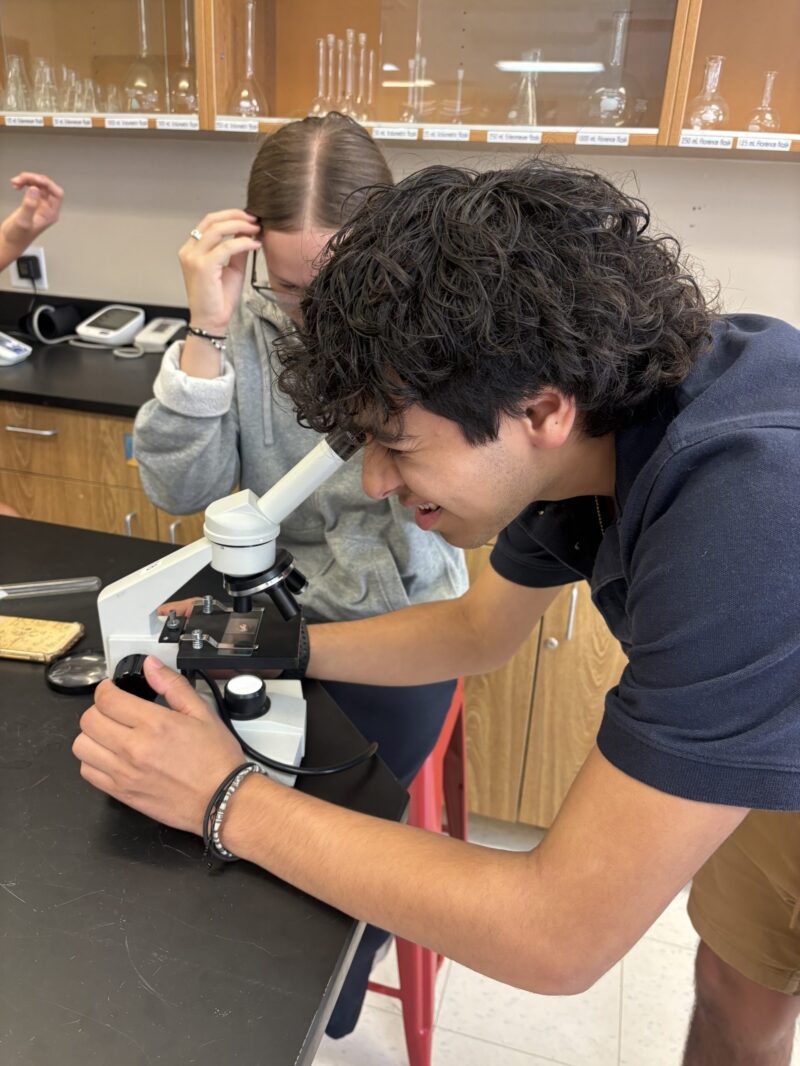
At SCA, science is all about discovery, exploration, and hands-on learning. From the microscopic world of cells to the grand principles of physics, our students are immersed in a rich, interactive curriculum that fosters curiosity, critical thinking, and a deep understanding of the natural world. In every science classroom, whether in Biology, Chemistry, Physics, or Environmental Science, students are not just learning theories—they are putting them into practice, testing hypotheses, and making sense of the world around them through direct experience.
In ninth grade Biology, our students are diving deep into the microscopic world. Using optical microscopes, they are carefully observing prepared slides of insects, muscle cells, and various tissue cross-sections. The hands-on experience doesn’t stop there! Students are encouraged to explore the natural world around them – examining everything from cheek cells and strands of hair to pond water – giving them a tangible understanding of cellular structures and processes. By engaging in this tactile, inquiry-based learning, they develop important skills in observation, data collection, and critical analysis.
In Chemistry, students are uncovering the secrets of the atomic world by studying the development of atomic theory—from John Dalton’s early models to Schrödinger’s quantum mechanical model. Recently, students have been investigating how energy can excite electrons in various elements. By heating different substances, students can observe the light emitted as electrons jump to higher energy levels and then fall back down, releasing visible light in the process – a phenomenon they observed with sodium in a pickle! As a fun bonus, several students teamed up to build a wave machine to demonstrate how both light and electrons can behave as both particles and waves—a fundamental concept in modern physics. This hands-on approach to studying atomic behavior helps students not only grasp difficult concepts but also enjoy the process of scientific discovery in action.
In Physics, students are applying Newton’s Laws of Motion in real-world contexts. As part of their study of forces, mass, acceleration, and velocity, students constructed balloon-powered cars to visually and physically demonstrate Newton’s Third Law of Motion (for every action, there is an equal and opposite reaction). But the fun doesn’t end there! To wrap up their unit on motion, students participated in a Pinewood Derby Car Race where they modified their cars to optimize performance. From adjusting mass to reducing air resistance and friction, students learned first-hand how science applies to everyday activities like racing cars. The culmination of this project gave students a deeper appreciation for the interplay of forces in the physical world and the role of experimentation in scientific problem-solving.
In Environmental Science, students are studying the intricate balance of ecosystems and how the Creator has designed the natural world to function in perfect harmony. Each student has created their own microbiome—a small, self-contained ecosystem complete with water, plants, small organisms, and decaying matter. Over the course of the next month, students will observe the development of their microbiomes to gain a hands-on understanding of how ecosystems thrive and how everything within them is interconnected. If a microbiome thrives, students will witness firsthand how nature’s circular systems, such as nutrient cycling, work to sustain life. If a microbiome fails, students will investigate the factors that caused the breakdown, developing a deeper understanding of ecological principles and the importance of balance in nature. This project brings to life the concept of interdependence within ecosystems and highlights the importance of sustainable practices.
At SCA, we believe that the best way to learn science is by doing it. By encouraging our students to experiment, observe, and test their ideas, we empower them to be curious, critical thinkers who understand the world around them on a deeper level. Whether it’s peering into a microscope, watching the flame colors of heated elements, building a car powered by air, or crafting an ecosystem in a jar, students at SCA are engaging in science in the most interactive, immersive way possible.
Through hands-on experiences, our students gain not only knowledge but also the essential skills of inquiry, problem-solving, and collaboration—tools that will serve them well in their future academic and professional careers. As they continue to explore the world around them, we are excited to see them grow into the scientists, engineers, and innovators of tomorrow.